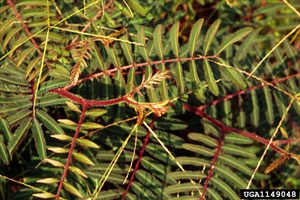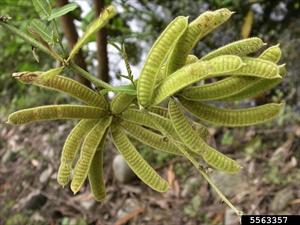- Widespread. Asia, Africa, North, South and Central America, Caribbean, Oceania. In Australia, Fiji, French Polynesia, New Caledonia, New Zealand, PNG.
- Shrub forming impenetrable thickets in grass floodplains, seasonal wetlands, swamps, waterways, ditches, and roadsides. Pastures are particularly impacted as cattle are cut off from watering points, and grazing capacity is reduced. Invasiveness due to rapid growth, ability to tolerate a range of soil types, and large seed production.
- Shrub, up to 2 m tall, with scattered thorns along stems, branches and leaf stalks. Leaves, alternate along the stems, about 20-30 cm long, divided into 6-16 pairs of leaf-like branchlets, each with about 45 pairs of leaflets. Flowerheads, 10-20 mm diameter, with about 100 pink or mauve flowers, eight stamens each, giving a fluffy look; these produce 8-20 hairy seed pods. When mature, pods break into 1-seeded pieces.
- Spread: seeds, by floodwater; machinery, vehicles, boats; movement of sand; clothing; animals - on fur and survival through the gut.
- Biosecurity: high risk of introduction; used as an ornamental and medicinally. One of the worst alien invasive weeds of wetlands of tropical Africa, Asia, Australia. Noxious weed in Florida and Hawaii, USA, northern Australia, Thailand and South Africa. Among 100 of World's Worst Invasive Alien Species (IUCN, 2020). Available on internet.
- Biocontrol: latest release in Australia is a beetle, Nesaecrepida infuscata, which attacks roots and leaves.
- Cultural control: hand weeding; slashing, plus herbicide; bulldozing; fire, plus herbicide; vehicle hygiene.
- Chemical control: in Australia: dicamba; fluroxpyr; glyphosate (and Fiji); glyphosate + metsulfuron-methyl; metsulfuron-methyl.








